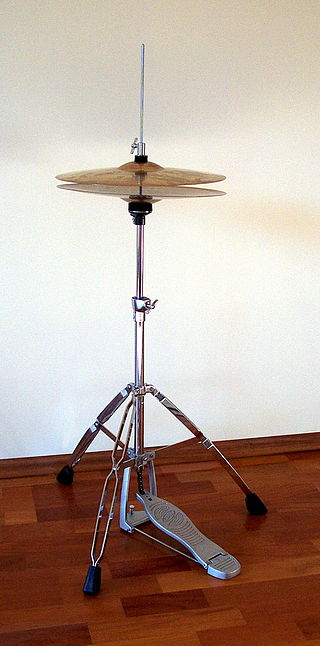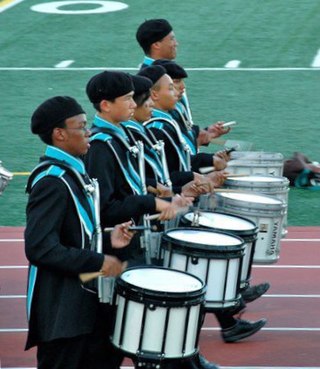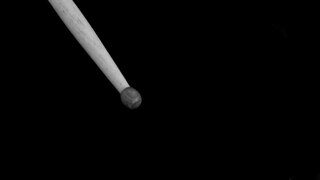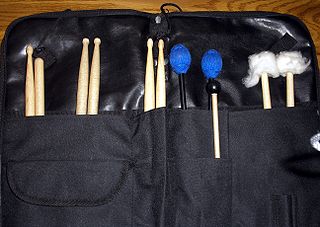
A cymbal is a common percussion instrument. Often used in pairs, cymbals consist of thin, normally round plates of various alloys. The majority of cymbals are of indefinite pitch, although small disc-shaped cymbals based on ancient designs sound a definite note. Cymbals are used in many ensembles ranging from the orchestra, percussion ensembles, jazz bands, heavy metal bands, and marching groups. Drum kits usually incorporate at least a crash, ride, or crash/ride, and a pair of hi-hat cymbals. A player of cymbals is known as a cymbalist.

A drum kit is a collection of drums, cymbals, and sometimes other auxiliary percussion instruments set up to be played by one person. The drummer typically holds a pair of matching drumsticks, and uses their feet to operate hi-hat and bass drum pedals.

A hi-hat is a combination of two cymbals and a pedal, all mounted on a metal stand. It is a part of the standard drum kit used by drummers in many styles of music including rock, pop, jazz, and blues. Hi-hats consist of a matching pair of small to medium-sized cymbals mounted on a stand, with the two cymbals facing each other. The bottom cymbal is fixed and the top is mounted on a rod which moves the top cymbal toward the bottom one when the pedal is depressed.

A percussion instrument is a musical instrument that is sounded by being struck or scraped by a beater including attached or enclosed beaters or rattles struck, scraped or rubbed by hand or struck against another similar instrument. Excluding zoomusicological instruments and the human voice, the percussion family is believed to include the oldest musical instruments. In spite of being a very common term to designate instruments, and to relate them to their players, the percussionists, percussion is not a systematic classificatory category of instruments, as described by the scientific field of organology. It is shown below that percussion instruments may belong to the organological classes of idiophone, membranophone, aerophone and chordophone.

The snare drum is a percussion instrument that produces a sharp staccato sound when the head is struck with a drum stick, due to the use of a series of stiff wires held under tension against the lower skin. Snare drums are often used in orchestras, concert bands, marching bands, parades, drumlines, drum corps, and more. It is one of the central pieces in a drum set, a collection of percussion instruments designed to be played by a seated drummer and used in many genres of music. Because basic rhythms are very easy to learn to play on a snare drum even for children, the instrument is also suitable for the music education for young children and a rhythm band.

The bass drum is a large drum that produces a note of low definite or indefinite pitch. The instrument is typically cylindrical, with the drum's diameter much greater than the drum's depth, with a struck head at both ends of the cylinder. The heads may be made of calfskin or plastic and there is normally a means of adjusting the tension either by threaded taps or by strings. Bass drums are built in a variety of sizes, but size does not dictate the volume produced by the drum. The pitch and the sound can vary much with different sizes, but the size is also chosen based on convenience and aesthetics. Bass drums are percussion instruments and vary in size and are used in several musical genres. Three major types of bass drums can be distinguished.
A crash cymbal is a type of cymbal that produces a loud, sharp "crash" and is used mainly for occasional accents, as opposed to a ride cymbal. It can be mounted on a stand and played with a drum stick, or by hand in pairs. One or two crash cymbals are a standard part of a drum kit. Suspended crash cymbals are also used in bands and orchestras, either played with a drumstick or rolled with a pair of mallets to produce a slower, swelling crash. Sometimes a drummer may hit two different crash cymbals in a kit at the same time to produce a very loud accent, usually in rock music.

Timpani or kettledrums are musical instruments in the percussion family. A type of drum categorised as a hemispherical drum, they consist of a membrane called a head stretched over a large bowl traditionally made of copper. Thus timpani are an example of kettle drums, also known as vessel drums and semispherical drums, whose body is similar to a section of a sphere whose cut conforms the head. Most modern timpani are pedal timpani and can be tuned quickly and accurately to specific pitches by skilled players through the use of a movable foot-pedal. They are played by striking the head with a specialized drum stick called a timpani stick or timpani mallet. Timpani evolved from military drums to become a staple of the classical orchestra by the last third of the 18th century. Today, they are used in many types of ensembles, including concert bands, marching bands, orchestras, and even in some rock bands.

Timbales or pailas are shallow single-headed drums with metal casing. They are shallower than single-headed tom-toms and usually tuned much higher, especially for their size. They were developed as an alternative to classical timpani in Cuba in the early 20th century and later spread across Latin America and the United States.

Snare technique is the technique used to play a snare drum.

A drum roll is a technique used by percussionists to produce a sustained sound for the duration of a written note.
All drum figures are based upon three fundamental beats, technically called roll, single stroke, and flam...Sustentation is accomplished upon wind instruments by blowing into the instrument; it is accomplished upon the violin and the allied instruments by drawing the bow across the string; it is accomplished upon the drum and allied percussion instruments by the roll.
THE SNARE DRUM ROLL.
The roll consists of an even reiteration of beats sufficiently rapid to prohibit rhythmic analysis. To produce an impression of sustentation, these beats must be absolutely even both in power and in sequence. Uneven beats in a roll destroy the impression of sustentation. Evenness is then the primary quality to strive for in roll; speed is the secondary quality to strive for.
There are two possible ways of producing an absolutely even sequence: (1) hand alternation of single stroke and (2) hand alternation of double strokes...The snare drum roll is produced by hand alternation of double strokes.
The "open roll" is produced by [initially] slow hand alternation. Two strokes in each hand alternately are produced by wrist movement and each beat should follow its predecessor in clock-like precision.

A percussion mallet or beater is an object used to strike or beat a percussion instrument in order to produce its sound.
In a drum kit, splash cymbals are the smallest accent cymbals. Splash cymbals and china cymbals are the main types of effects cymbals.
A rimshot is a percussion technique used to produce an accented snare drum backbeat. The sound is produced by simultaneously hitting the rim and head of the drum with a drum stick.

Stephen Kendall Gadd is an American drummer, percussionist, and session musician. Gadd is one of the best-known and highly regarded session and studio drummers in the industry, recognized by his induction into the Modern Drummer Hall of Fame in 1984. Gadd's performances on Paul Simon's "50 Ways to Leave Your Lover"(1976) and "Late in the Evening", Herbie Mann's "Hi-jack"(1975) and Steely Dan's "Aja"(1977) are examples of his style. He has worked with other popular musicians from many genres including Simon & Garfunkel, James Taylor, Chick Corea, Chuck Mangione, Eric Clapton and Michel Petrucciani.
Orchestral percussion refers to the various percussion instruments used in an orchestral setting. It may also refer to the act of playing such instruments in an orchestral style. Many music schools and conservatories offer training for musicians interested in developing their skills as orchestral percussionists. Typically, an orchestral percussionist does not specialize in one particular instrument. Although there is no exhaustive list of all instruments that an orchestral percussionist must be able to play, there are particular instruments that are frequently used in the orchestral repertoire. This includes timpani, snare drum, bass drum, xylophone, glockenspiel, triangle, and tambourine.

The bladder fiddle was a folk instrument used throughout Europe and in the Americas. The instrument was originally a simple large stringed fiddle made with a long stick, one or more thick gut strings, and a pig's-bladder resonator. It was bowed with either a notched stick or a horsehair bow.
A sting, sometimes called a sounder, is a short musical phrase, primarily used in broadcasting and films as a form of punctuation. For example, a sting might be used to introduce a regular section of a show, indicate the end of a scene, or indicate that a dramatic climax is imminent. A classic sting is the "Dun dun duuun!" played to indicate a period of suspense.

In percussion, cymbal choke is a drum stroke or push which consists of striking a cymbal with a drum stick held in one hand and then immediately grabbing the cymbal with another hand, or more rarely, with the same hand. The cymbal choke produces a burst of sound which is abruptly silenced, which can be used for punctuation or dramatic fortissimo effects. In some modern music, namely heavy metal, it is "often employed to emphasize a particular beat or signal an abrupt conclusion to a passage." Cymbal chokes are used extensively by classical percussionists to muffle the sound of a cymbal in accordance with the composer's notation, or in an attempt to match the sustain of other instruments in the ensemble. "The effect, a sudden burst of sound, is [often] further strengthened by a single, simultaneous kick with the bass drum."
For 'choke' cymbal, strike the suspended cymbal with the tip of a wood stick and dampen the sound immediately after the duration of the note.
[In] ragtime [1890-1920]...a lot of time there would be a crash cymbal, or a choke cymbal as they called it, that was usually played with a mallet. They would strike the cymbal with one hand and choke it with the other hand. And there were different techniques for choking the cymbals. Sometimes, they would really cut the cymbal and make it real staccato...Or they would play other styles where they would let the cymbal ring a little bit and sustain itself, and then catch it.
A rimshot is a percussion technique used to produce an accented snare drum backbeat.















